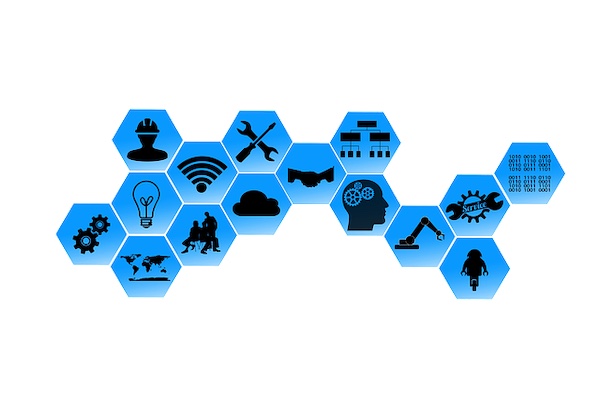What is Industry 4.0?
Industry 4.0 is a term used to describe the merging of digital technologies and the internet with conventional industrial processes and business methods. It involves the use of cyber-physical systems and automated processes enabled by internet connectivity, computer-based algorithms, data analytics, and business intelligence.
According to John Kawola, CEO of Boston Micro Fabrication, digital technologies have “moved into manufacturing and are starting to have a real impact–in robotics, tools, sensors or Internet of Things (IoT) technology that keeps track of everything in an automated way.”
The following are current Industry 4.0 trends that we believe will continue in 2020 and beyond:
Industrial Internet of Things (IIoT)
The Industrial Internet of Things is the application of Information Technology (IT) and Operational Technology (OT) in the manufacturing sector. IIoT includes several forms of IoT-enabled industrial applications such as medical devices, robotics, and computer-aided production processes. The main purpose of implementing smart technology in the manufacturing sector is harnessing the large volumes of data that “dumb” machines generate to optimise production and/or make better business decisions.
An IIoT system typically consists of the following components:
Interconnected “intelligent” devices that monitor, analyse, and exchange information about industrial processes–usually, the system consists of smart sensors, actuators, and software.
-
The personnel that supervise and control these systems
-
Data communications infrastructure (public or private)
-
Data analytics and business intelligence applications
IoT systems have numerous benefits in manufacturing or production. For example, predictive maintenance in IIoT systems can help monitor in-service machinery to predict failures before they happen. It ensures that in-service machinery/equipment are repaired or overhauled before failures, ensuring maximum uptime, lowering maintenance costs, and avoiding costly replacements.
Another essential benefit of IIoT is the ability to obtain insight into consumer behaviour. Since all products are connected, manufacturers can analyse the data to observe how end-users interact with their products and make improvements in subsequent models to better meet their business needs.

Smart machines will enable precision manufacturing now and in the future.
Smart Manufacturing
A key area currently experiencing disruption via digital transformation is manufacturing.
Smart manufacturing integrates wireless connectivity and sensors into machinery to optimize production. Using process automation and data analytics, manufacturers can:
-
Monitor production to reduce waste and prevent deviations due to human error
-
Obtain real-time data from processes to improve performance and prevent machine failures
-
Establish communication networks between individual machines to enhance automation
Smart manufacturing technologies utilise sensors, artificial intelligence (AI), drones and driverless vehicles, edge computing, and predictive analysis to monitor industrial processes. Data analytics analyzes large amounts of data from processes to uncover trends, material characteristics, and fault conditions that affect production.
Some of the biggest challenges for large-scale smart manufacturing are a lack of standardization and low interoperability. Since technical specifications, like operating systems and source code for smart machines, remain mostly diverse—it's difficult to transfer and scale-up production across multiple organizations. Similarly, poor semantic interoperability between smart manufacturing machines prevents accurate interpretation of information.
Artificial Intelligence (AI)
Arguably the most discussed technological development in the past decade, artificial intelligence will shape the industrial sector in several more to come. AI enables higher productivity and efficiency at industrial facilities through seamless machine-to-machine (M2M) interactions and real-time collaboration between humans and robots.
At the core of AI’s benefits to Industry is the ability of machines to make decisions in a similar way to humans and learn without being supervised using advanced neural networks—aka deep learning.
Deep learning works hand-in-hand with digital technologies such as big data analytics and cloud computing to generate business intelligence from vast amounts of machine data. The predictive analytics of AI-enabled systems allows organizations to optimise production processes by “learning by example”, from feedback provided by the machines.

Reports from data analytics can generate actionable business intelligence for manufacturers.
Human-Machine Interfaces
A human-machine interface (aka HMI) consists of hardware and software components that enable interactions between users and industrial machinery. Unlike the basic “switching” (ON/OFF or START/STOP) functions of early systems, HMIs have become more sophisticated than ever, allowing machines to carry out a host of complex instructions. Additionally, they can communicate the status or condition of equipment to employees working in factories and plants.
Modern HMIs utilise smart sensors, smart devices, machine learning (ML), wireless connectivity and more to send and receive data over the cloud. They can be embedded within various equipment or function as standalone systems.
Applications of HMIs in manufacturing and production are diverse. Unsurprisingly, a press release by Grandview Research shows that the global HMI market will be worth $6.3 billion as new industrial applications emerge. For example, ReplicAnt, an HMI-controlled 3D visualization technology uses special simulation modules to send instructions to programmable logic controllers (PLCs) that control production at factories and plants.
The Effect of 4 Trends
These four Industry 4.0 trends are some of the most evident in the last five years. With the shift towards the use of cyber-physical systems, industries should experience greater productivity and efficiency, as well as increased scalability.





